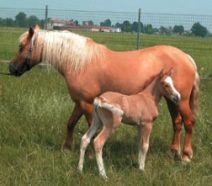Like mother, like daughter
Scientists have for the first time created a horse by cloning.
By Emily Sohn
A horse is a horse, of course. Unless, of course, you visit a lab in Italy, where scientists have for the first time created a horse by cloning.
The baby horse is a female named Prometea. In a strange twist of technology, it is a genetic twin of the mother horse that gave birth to it.
 |
|
Prometea, the first cloned horse, and her genetically identical mother.
|
| G. Lazzari/Nature |
Scientists have been using artificial reproduction techniques to clone a variety of creatures in recent years. Clones have exactly the same genes as each other, like identical twins.
Earlier this summer, researchers in Idaho reported that they had successfully cloned a mule. That was a big deal because a mule is a cross between a male donkey and a female horse, and it’s usually sterile, which means that mules can’t have their own babies.
Since then, researchers have been racing to clone horses. The Italian researchers began by taking undeveloped eggs out of the ovaries of a dead horse. Then, they replaced the DNA of those eggs with DNA from the skin cells of one of two living horses.
More than 800 eggs started to grow. Of those, 22 embryos survived. The researchers then inserted the embryos into the uteruses of fill-in mother horses. Four pregnancies followed. One horse, Prometea, was born. By chance, Prometea’s birth mother also donated the DNA for the foal’s egg, making mom and daughter identical twins.
Racehorse owners are excited about the potential for cloning their prize animals. Scientists are excited because Prometea challenges the long-held belief that a mother’s immune system would reject a genetic clone of herself.
Prometea’s Mom must be proud, too. Thanks to science, she gets to watch an identical version of herself grow up all over again.







